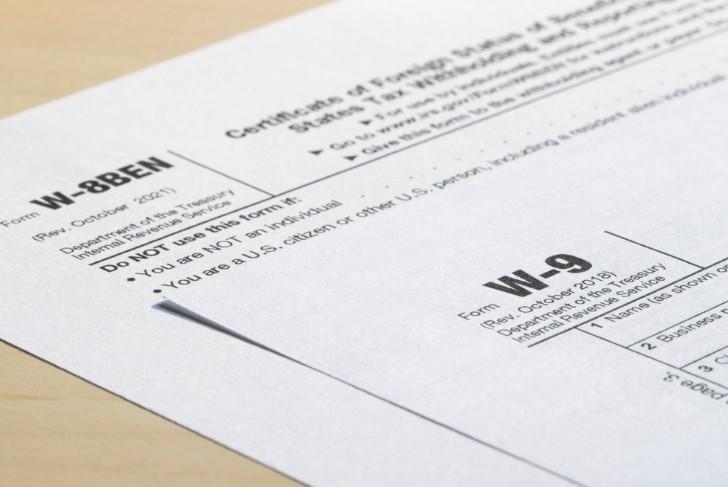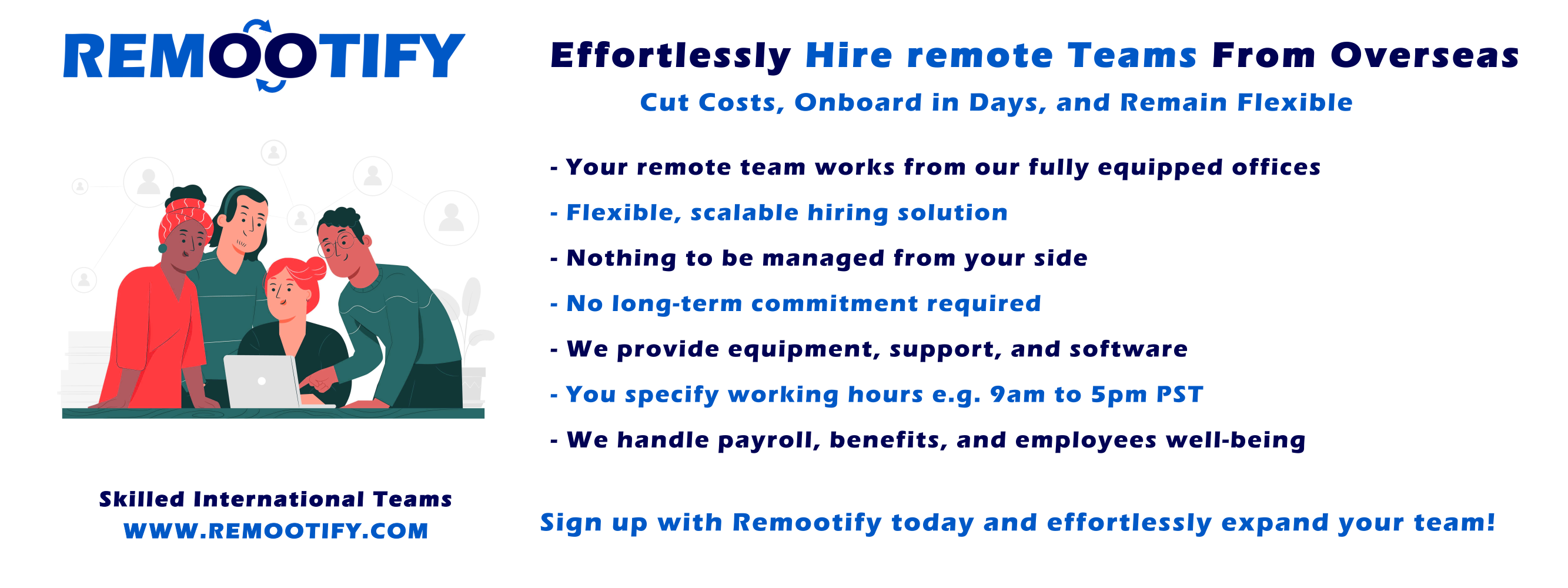Start hiring YOUR REMOTE TEAM, Today!
Enter your information below to start a discussion with one of our team members!

Are you puzzled by tax forms W-9 and W-8? These documents play a crucial role in accurately reporting taxable income to the Internal Revenue Service (IRS). This blog post will offer a straightforward comparison between these two forms, helping you understand who needs to fill them out and when.
Stay tuned for useful insights that could simplify your tax filing experience!
Key Takeaways
- W-9 forms are for US citizens and companies in the United States, while W-8 forms are for non-US citizens or US citizens living outside of the US.
- The purpose of the W-9 form is to report tax ID numbers, while the W-8 form certifies foreign status.
- Different types of W-8 forms exist, such as W-8 BEN, W-8 BEN-E, W-8 ECI, W-8 EXP, and W-8IMY, each serving specific purposes based on residency or entity classification.
What Are W-9 and W-8 Forms?
W-9 and W-8 forms are tax forms used to collect taxpayer identification information, but they differ in terms of who needs to fill them out.
Definition and purpose
W-9 forms are for companies in the United States. They use this form to tell the tax people their tax ID numbers. W-8 forms help say “I am not living in America”. People who live outside of America and are not American citizens use it.
This is also used by Americans who live out of America, like in other countries. The W-9 form helps make sure you pay your taxes right if you’re self-employed or a business in America.
But the W-8 form helps say you don’t have to pay some income tax because you’re foreign.
Differences between the two forms
The main difference between the W-9 and W-8 forms is who fills them out. The W-9 form is for US citizens or companies in the United States, while the W-8 form is for non-US citizens or US citizens living outside of the US.
The purpose of the forms also differs – the W-9 form is used to report tax ID numbers, while the W-8 form certifies foreign status. So, if you’re a US citizen or company, you’ll need to fill out a W-9 form, but if you’re not a US citizen or resident, you’ll need to complete a W-8 form.
Remember that these forms help ensure accurate tax payments and comply with tax regulations.
Who should fill out each form
US taxpayers, including self-employed individuals and entities within the United States, should fill out the W-9 form to report their tax identification numbers. On the other hand, non-US citizens or US citizens living outside of the US should fill out the W-8 form to certify their foreign status and claim exemption from withholding on income effectively connected with their conduct.
The W-9 is for individuals and entities in the US, while the W-8 is for non-US taxpayers.
Types of W-8 Forms
There are several types of W-8 forms, including the W-8 BEN, W-8 BEN-E, W-8 ECI, W-8 EXP, and W-8IMY.
W-8 BEN
The W-8 BEN form is used by non-US residents to claim an exemption from withholding tax on income earned in the United States. It certifies that the filer is a foreign person and provides their taxpayer identification number.
The W-8 BEN form is crucial for non-US citizens who want to avoid unnecessary taxes on their US income. It helps ensure compliance with tax regulations and allows individuals to take advantage of any applicable tax treaties between their home country and the United States.
By filling out the W-8 BEN form correctly, non-US residents can minimize their tax obligations and avoid potential penalties for incorrect or incomplete documentation.
W-8 BEN-E
The W-8 BEN-E form is a specific type of W-8 form used by foreign entities. It stands for “Certificate of Status of Beneficial Owner for United States Tax Withholding and Reporting (Entities)”.
This form is used to certify that the entity is claiming a tax treaty benefit or exempt from withholding on certain types of income.
Foreign entities, such as corporations, partnerships, or trusts, who receive income from US sources can use the W-8 BEN-E form to establish their status. By filling out this form correctly, they can claim reduced withholding taxes under an applicable tax treaty between their home country and the United States.
When completing the W-8 BEN-E form, it’s important to provide accurate information about the entity’s name, address, and country of residence. The entity must also indicate its classification (e.g., corporation or partnership) and provide details about any controlling persons or beneficial owners.
W-8 ECI
The W-8 ECI form is one of the types of W-8 forms used to certify foreign status for tax purposes. The acronym “ECI” stands for “Income Effectively Connected with the Conduct.” This means that if you are a non-US citizen or a US citizen living outside of the US and you have income that is considered connected to conducting business in the US, you would use this form.
The W-8 ECI form is used to claim an exemption from withholding on income that is effectively connected with your activities in the United States. It helps ensure that appropriate taxes are paid on your earnings while taking into account any applicable tax treaty provisions.
W-8 EXP
The W-8 EXP form is one type of the W-8 forms used for tax purposes. It stands for “Certificate of Foreign Government or Other Foreign Organization for United States Tax Withholding and Reporting.” This form is specifically designed for foreign governments or international organizations that are exempt from certain tax withholding requirements in the United States.
By submitting this form, these entities can claim their exemption status and provide necessary taxpayer identification information. The W-8 EXP form helps ensure proper tax compliance and reporting for foreign governments and organizations operating in the US.
W-8IMY
The W-8IMY form is one of the types of W-8 forms that is used for tax purposes. It stands for “Certificate of Foreign Intermediary, Foreign Flow-Through Entity, or Certain U.S. Branches for United States Tax Withholding and Reporting.” This form is specifically meant to be filled out by foreign intermediaries, foreign flow-through entities, or certain U.S. branches that want to claim an exemption from withholding tax on income effectively connected with their conduct in the United States.
The W-8IMY form provides important taxpayer identification information and helps ensure compliance with U.S. tax regulations for these entities.
How to Fill Out Each Form
To fill out the W-9 form, provide your name, address, and taxpayer identification number. For the W-8 forms, follow step-by-step instructions based on the specific form you are filling out, ensuring accurate and complete information is provided.
Step-by-step instructions for completing W-9
To complete a W-9 form, follow these simple steps:
1. Obtain the form: You can find the W-9 form on the Internal Revenue Service (IRS) website or request it from your employer or client.
2. Fill in your personal information: Provide your name, address, and taxpayer identification number (usually your social security number).
3. Check the appropriate box: Indicate whether you are an individual or a business entity by checking the corresponding box.
4. Exemptions: If you are exempt from backup withholding due to being subject to certain tax exemptions or treaty benefits, check the exemption box and provide any necessary details.
Guidelines for filling out W-8 forms
When filling out W-8 forms, there are some important guidelines to keep in mind. First, make sure to provide accurate taxpayer identification information. This is crucial for establishing your foreign status and claiming exemption from withholding on income effectively connected with the conduct.
Secondly, ensure that you choose the correct type of W-8 form based on your specific circumstances. There are different types such as W-8 BEN, W-8 BEN-E, W-8 ECI, W-8 EXP, and W-8IMY depending on your residency or entity classification.
Follow the instructions carefully when completing each section of the form and double-check for any mistakes or missing information before submitting it. Lastly, be aware of any common mistakes people often make when filling out these forms so you can avoid them.
Common mistakes and how to avoid them
To avoid common mistakes when filling out W-9 and W-8 forms, it’s important to pay attention to the details. One common error is providing incorrect information or leaving fields blank.
Double-check all the required fields and make sure you enter accurate data, including your tax identification number and personal details. Another mistake is not filling out the forms in their entirety.
Make sure to complete all sections of the form as instructed. Additionally, be aware of any specific instructions or guidelines provided by the IRS for each form type. Finally, remember to keep track of deadlines for submitting these forms so that you don’t miss any important dates.
When and How to Collect These Forms
Learn the circumstances that require W-9 and W-8 forms to be completed, and discover efficient methods for collecting and managing these important tax documents.
Circumstances that require W-9 and W-8 forms to be filled out
W-9 and W-8 forms need to be filled out in different situations. The W-9 form is required if you’re a US citizen or resident, or an entity within the United States, such as a company or association.
It’s used to report your tax ID number for accurate tax payments. On the other hand, the W-8 form is needed if you’re a non-US citizen or US citizen living outside of the United States.
This form certifies your foreign status and exempts you from certain withholding taxes on income effectively connected with conduct outside of the US. So, depending on your citizenship and residency status, along with where you live and conduct business, either the W-9 or W-8 form will be applicable to you.
How to collect and manage these forms efficiently
To collect and manage W-9 and W-8 forms efficiently, it’s important to have a clear process in place. Start by educating your team or employees about the purpose of these forms and when they need to be filled out.
Make sure that everyone understands who should fill out each form – US citizens or entities for the W-9, and non-US citizens or US citizens based outside of the US for the different types of W-8 forms.
When collecting these forms, consider using digital platforms or software that allow for easy submission and organization. This way, you can eliminate paperwork and reduce errors or lost documents.
Additionally, regularly communicate with your team to remind them about any updates to tax regulations or changes in form requirements.
To manage these forms efficiently, create a centralized system where all completed forms are stored securely. Ensure that only authorized personnel have access to this information.
Regularly review and update this database as needed.
Additional Resources and FAQs
Find helpful articles and guides on W-9 and W-8 forms, get answers to common questions, and discover how Multiplier can assist with tax form management. Dive deeper into understanding the differences between these forms!
Helpful articles and guides on W-9 and W-8 forms
If you want to learn more about W-9 and W-8 forms, there are helpful articles and guides available. These resources can provide step-by-step instructions on how to fill out each form correctly.
They also offer guidelines for avoiding common mistakes when completing the forms. You can find answers to frequently asked questions and gain a better understanding of the tax implications associated with these forms.
Additionally, if you need assistance with managing your tax form documentation, services like Multiplier can help ensure compliance with IRS requirements.
How Multiplier can assist with tax form management
Multiplier is a helpful tool that can assist with tax form management. It simplifies the process of collecting and managing W-9 and W-8 forms efficiently. With Multiplier, you can easily gather and store these forms electronically, eliminating the need for paper-based processes.
It also provides step-by-step instructions for filling out each form correctly, helping you avoid common mistakes. Additionally, Multiplier ensures compliance with tax regulations by providing accurate reporting and documentation.
By using Multiplier, you can streamline your tax form management process and stay organized with ease.
Conclusion
In conclusion, it is important to understand the difference between the W-9 and W-8 forms. The W-9 form is used by US citizens and companies within the United States, while the W-8 form is used by non-US citizens or US citizens based outside of the US.
These forms serve different purposes and are necessary for accurate tax reporting and compliance. By understanding when and how to use each form, individuals and businesses can ensure they meet their tax obligations correctly.
FAQs
1. What is the difference between W-9 and W-8 forms?
W-9 forms are for US residents while W-8 forms are for nonUS citizens or foreign persons.
2. Who needs to fill out these IRS forms?
If you live in the USA, you fill out a W-9 form. If you live outside of USA and do not have resident status, you need a W-8 form.
3. Why are these tax documents important?
These IRS forms help figure out your foreign tax duties and how much international tax one should pay.
4. Can I use a W-8 form if I am a US citizen living abroad?
No! Even if an individual lives abroad but they hold US-resident status, that person must still use the American-based W-9 form.





